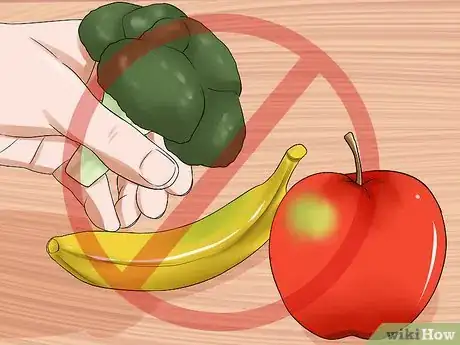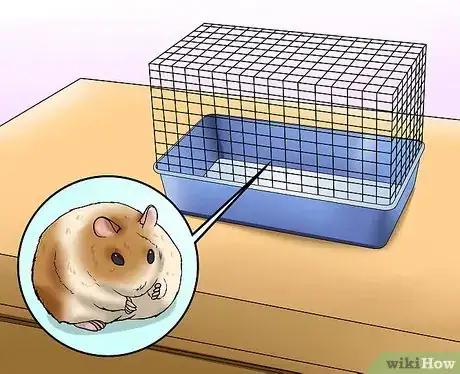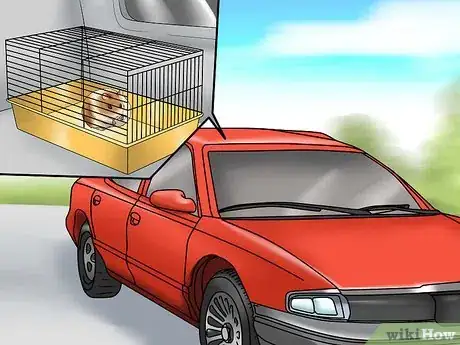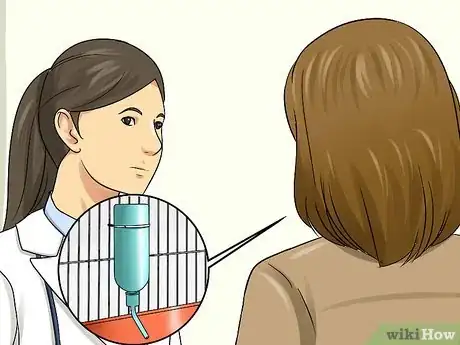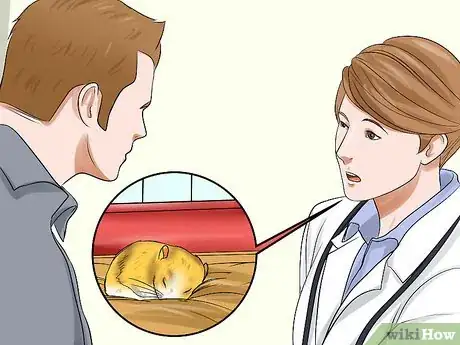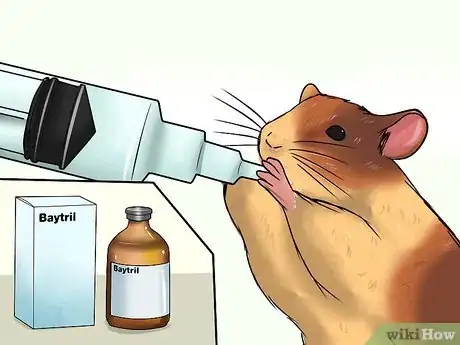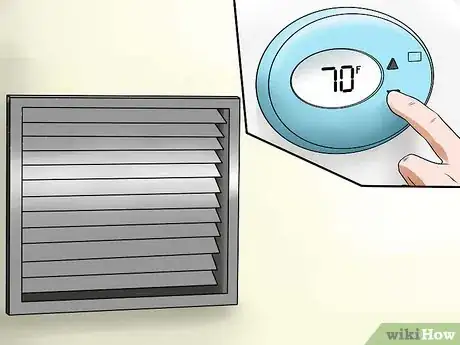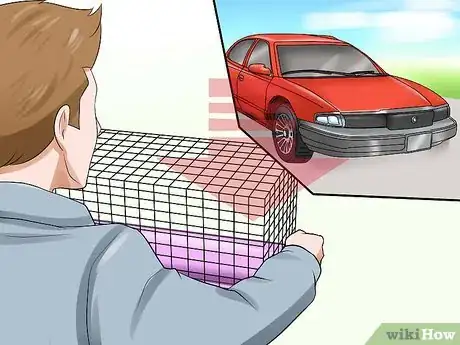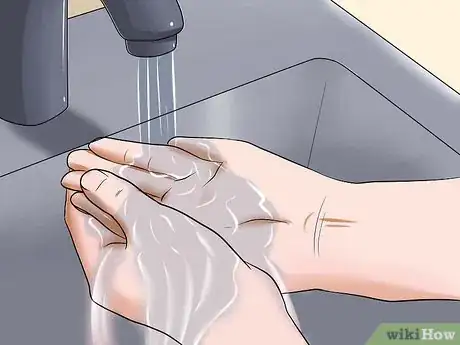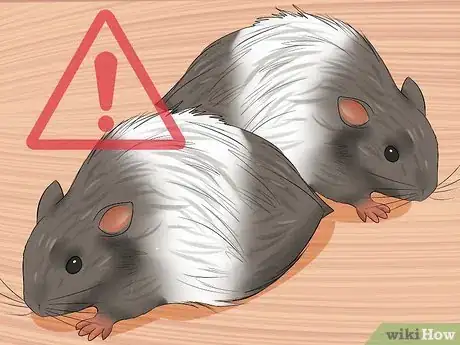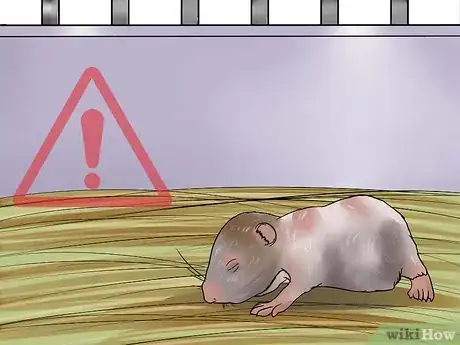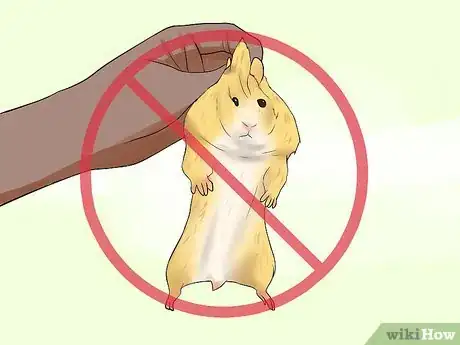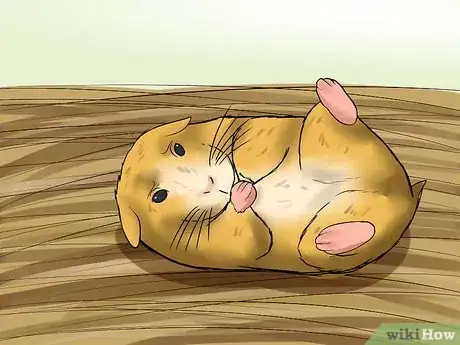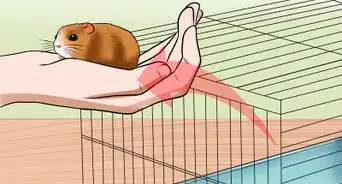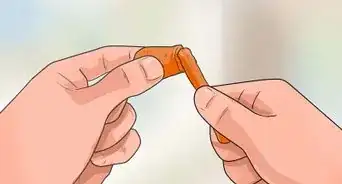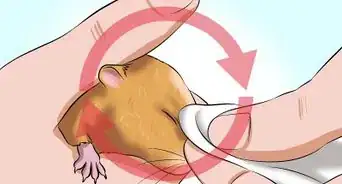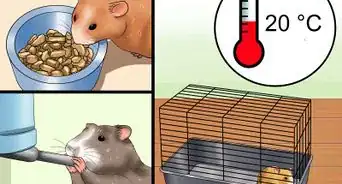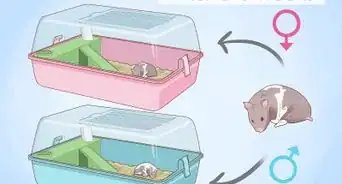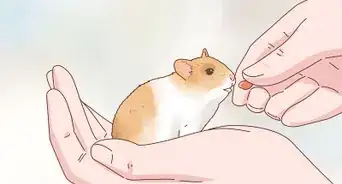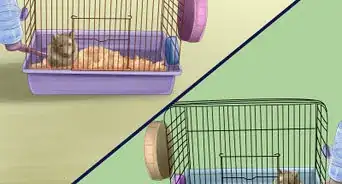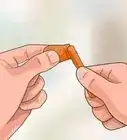This article was co-authored by Pippa Elliott, MRCVS. Dr. Elliott, BVMS, MRCVS is a veterinarian with over 30 years of experience in veterinary surgery and companion animal practice. She graduated from the University of Glasgow in 1987 with a degree in veterinary medicine and surgery. She has worked at the same animal clinic in her hometown for over 20 years.
wikiHow marks an article as reader-approved once it receives enough positive feedback. This article received 13 testimonials and 90% of readers who voted found it helpful, earning it our reader-approved status.
This article has been viewed 411,038 times.
Wet tail (also called proliferative ileitis or transmissible ileal hyperplasia) is a bacterial infection that affects hamsters.[1] Wet tail results in severe diarrhea, and takes its name from the "wet tail" that results from soft, watery droppings. Hamsters with this infection can suffer from severe dehydration from the diarrhea, which can be fatal. You need to know what you can do to improve your hamster's chances of recovery.
Steps
Treating Wet Tail
-
1Check for the signs of wet tail. The hallmark of this condition is wetness around the hamster's tail — hence the name "wet tail". However, this is a description rather than a diagnosis in its own right. What we call "wet tail" can actually have several different causes, but the result is the same: diarrhea and fluid loss. The following signs indicate wet tail in a hamster:[2]
- Tail end and sometimes abdomen are wet, matted
- The wet area is soiled and smells bad from excessive watery diarrhea
- Failure to groom, dull, ruffled coat
- Dull, sunken eyes
- Abdominal discomfort, which can show itself as grumpiness or aggression
- Lethargy, hiding away and being reclusive
- Irritability, discomfort, and hunched posture
- Protruding rectum caused by straining
- Weight loss
- Loss of appetite and low energy levels.[3]
-
2Remove fruits and vegetables from the diet. Before seeing the vet, do not remove all food, but remove fruits and vegetables. Your vet will provide further advice on diet once he’s examined the animal. Dry food "binds" the bowels better than fruit and vegetables. More watery foods can encourage diarrhea, so removing fruits and vegetables from the diet can help prevent it.Advertisement
-
3Isolate the sick hamster. Wet tail can be contagious, so it's best to be on the side of caution. Separate your sick hamster from any others you may have to prevent the illness from spreading. The sick hamster may prefer to be left alone anyway, so isolation can reduce its stress levels. Consider asking a trusted friend to care for your healthy hamsters during the recovery period. This will allow you to concentrate on the sick ones. It also reduces stress for yourself and for your hamster.
-
4Take your little friend to the vet. The vet will prescribe a course of antibiotics as well as medication to cure diarrhea. Avoid adding antibiotics to food and water. Your hamster probably isn't eating drinking anyway, so this would be an ineffective way to medicate him. If he is drinking, you don't want to discourage this by putting something that tastes strange in the water. If the hamster is very unwell, the vet may give antibiotics by injection to ensure he gets the correct dose.
- Because hamsters are so small, it's hard to run diagnostic tests (bloods and imaging) on them. This makes it difficult for the vet to reach a definitive diagnosis of the underlying cause of the illness.
-
5Ask the vet to hydrate the hamster if necessary.[4] If the hamster is very dehydrated, ask if the vet recommends giving him an injection of saline under the skin. You can check for extreme hydration by pinching the skin on the back of the neck. Healthy, hydrated skin will snap back immediately. If it takes longer than 2 seconds to return to normal, you should raise concerns of dangerous dehydration.
- A saline injection does not always make as much difference as hoped because absorption can be slow when the animal is unwell.
-
6Allow the vet to hospitalize your pet if recommended. If the vet is concerned about the hamster's health, defer to his opinion. He may ask you to leave your pet at the clinic so the staff can administer fluids regularly and give additional antibiotics by injection.
-
7Give the hamster its medication at home.[5] If the vet doesn’t recommend hospitalization, you need to be attentive to your pet's medical care at home. Your vet may prescribe an antibiotic called Baytril to be taken by mouth. This is a very concentrated antibiotic, and the dose is usually one drop per day. The vet may also suggest dripping a balanced electrolyte solution (Lectade or Pedialyte) into the hamster's mouth to keep it hydrated. This needs to be done with great care to avoid flooding the hamster's lungs.
- The best way is to give the electrolyte solution is with an eyedropper. Squeeze a single drop of the solution from the dropper and touch it to the hamster's lips.
- The surface tension of the solution will cause the drop to soak the hamster's mouth, which it will then lick dry.
- This should be done every half-hour to hour, if possible.
-
8Keep the hamster warm. Small mammals like hamsters have a large ratio of surface area to volume. As a result, they can get dangerously cold very easily when they are sick. A hamster's ideal environment should be between 70-80F.[6]
-
9Reduce stress. Experts believe wet tail to be a stress-related disease, so that's the last thing your buddy needs.[7] Remove any source of distraction or stress from the room where the hamster is resting. This includes other hamsters, barking dogs, inquisitive cats, bright lights, and anything noisy.
- Other than removing wet foods from its diet, do not change the usual food unless your vet advises you to. This can cause more stress.
- Try not to move the hamster around more than necessary, beyond vet visits and initial isolation. Transportation is a source of stress.
-
10Practice good hygiene at all times during the care period. This is especially important when you have more than one hamster, as sloppiness might spread the infection.
- Always wash your hands before and after handling the hamster.
- Keep everything clean, including the cage, drink bottle, food dish, and toys.
- Clean the cage every 2 or 3 days. Trying to clean it any more often can result in additional stress, which is not good for the hamster's recovery.
-
11Be prepared to make a difficult decision. Unfortunately, hamsters often don't respond well to therapy. so if your hamster develops signs, be prepared for the worst and that they might not get better. The success rate for treating wet tail is low, and if the hamster does not rally within 24 - 48 hours then the chances are it won't. If, despite all your efforts, the hamster continues to deteriorate, it may kinder to consider putting your pet to sleep.
- Look for dehydration (lifting his scruff and watching it fall back down), lack of activity, lack of response when touched or handled, continued diarrhea, and a foul smell which is getting worse.
- If you start treatment and the hamster's condition worsens, at least you gave him a chance. But it may now be kinder to relieve him of his pain and let him go.
Knowing the Risk Factors
-
1Consider the hamster’s breed. Dwarf hamsters can get severe diarrhea, but they do not get wet tail. Long-haired teddy hamsters, on the other hand, seem to be the most prone to wet tail.[8] Ask your breeder or veterinarian about your breed’s risk of wet tail when purchasing hamsters, so you know your pet’s risks.
-
2Keep an eye on young hamsters. Very young hamsters between 3 - 8 weeks of age seem especially vulnerable to infection. This is likely because their immune systems are still developing, and aren't very good at fighting off bugs yet. Research suggests that most the bacteria most likely to cause wet tail is the Desulfovibrio species.[9]
-
3Don’t over-handle newly weaned hamsters. The most easily affected hamsters seem to be weaned baby hamsters up to the age of 8 weeks.[10] Always give new hamsters time to adjust to their new surroundings before handling them too much. Otherwise, you might stress them out too much and contribute to wet tail conditions.
- Give new hamsters about a week to settle in before handling them often.
- It is also a good idea to isolate them during this time, as wet tail can be incubating for 7 days before the symptoms appear.[11]
-
4Be aware of gastrointestinal disturbances.[12] Adult hamsters tend to develop the symptoms if the balance of microorganisms in their guts is disturbed. This lets a bacterium called clostridium overwhelm the gut, causing diarrhea and wet tail symptoms. Factors which can trigger the initial gastrointestinal disturbance include:
- Stress (for example, from an overcrowded cage or from fear of a predator like a house cat)
- Change of diet
- Certain antibiotics given by mouth for other illnesses
-
5Take the hamster’s other conditions into consideration.[13] It may well be that the gastrointestinal problems arise not from disturbances like stress or diet, but from an underlying medical condition. Conditions like irritable bowel syndrome or bowel cancer can be contributing factors to wet tail.
Expert Q&A
-
QuestionMy hamster has a lump on her right side and hasn't produced any pellets for a while. What can I give her?
 Pippa Elliott, MRCVSDr. Elliott, BVMS, MRCVS is a veterinarian with over 30 years of experience in veterinary surgery and companion animal practice. She graduated from the University of Glasgow in 1987 with a degree in veterinary medicine and surgery. She has worked at the same animal clinic in her hometown for over 20 years.
Pippa Elliott, MRCVSDr. Elliott, BVMS, MRCVS is a veterinarian with over 30 years of experience in veterinary surgery and companion animal practice. She graduated from the University of Glasgow in 1987 with a degree in veterinary medicine and surgery. She has worked at the same animal clinic in her hometown for over 20 years.
Veterinarian Gently syringe some water or Pedialyte into the hamster's mouth, a drop at a time, and keep her warm. Monitor her to see if she is eating and to check what she is passing. If she doesn't start eating and pooping within six hours or so, then get her checked by a vet.
Gently syringe some water or Pedialyte into the hamster's mouth, a drop at a time, and keep her warm. Monitor her to see if she is eating and to check what she is passing. If she doesn't start eating and pooping within six hours or so, then get her checked by a vet. -
QuestionI got a teddy bear hamster yesterday. This morning she looks tired, and her poop is brown and mushy. Could she have wet tail?
 Pippa Elliott, MRCVSDr. Elliott, BVMS, MRCVS is a veterinarian with over 30 years of experience in veterinary surgery and companion animal practice. She graduated from the University of Glasgow in 1987 with a degree in veterinary medicine and surgery. She has worked at the same animal clinic in her hometown for over 20 years.
Pippa Elliott, MRCVSDr. Elliott, BVMS, MRCVS is a veterinarian with over 30 years of experience in veterinary surgery and companion animal practice. She graduated from the University of Glasgow in 1987 with a degree in veterinary medicine and surgery. She has worked at the same animal clinic in her hometown for over 20 years.
Veterinarian Wet tail is one possibility, although from what you write, this sounds more like settling-in problems. Your hamster has had a major change in the past 24 hours, and this alone is stressful. Stress can cause soft pellets and even diarrhea, so this could be one explanation. Also, hamsters are active at night, so she may well be sleepy this morning.
Wet tail is one possibility, although from what you write, this sounds more like settling-in problems. Your hamster has had a major change in the past 24 hours, and this alone is stressful. Stress can cause soft pellets and even diarrhea, so this could be one explanation. Also, hamsters are active at night, so she may well be sleepy this morning. -
QuestionCould a hamster with diarrhea, weight loss, and a hunched over back could be a bad case of wet tail?
 Pippa Elliott, MRCVSDr. Elliott, BVMS, MRCVS is a veterinarian with over 30 years of experience in veterinary surgery and companion animal practice. She graduated from the University of Glasgow in 1987 with a degree in veterinary medicine and surgery. She has worked at the same animal clinic in her hometown for over 20 years.
Pippa Elliott, MRCVSDr. Elliott, BVMS, MRCVS is a veterinarian with over 30 years of experience in veterinary surgery and companion animal practice. She graduated from the University of Glasgow in 1987 with a degree in veterinary medicine and surgery. She has worked at the same animal clinic in her hometown for over 20 years.
Veterinarian It can't be ruled out, as wet tail is often used as a blanket term indicating any serious diarrhea. However, a hamster with true wet tail produces extremely liquid, almost watery diarrhea, and sadly, one of the hallmarks of the problem is that it can be fatal within just a couple of days.
It can't be ruled out, as wet tail is often used as a blanket term indicating any serious diarrhea. However, a hamster with true wet tail produces extremely liquid, almost watery diarrhea, and sadly, one of the hallmarks of the problem is that it can be fatal within just a couple of days.
Warnings
- Disinfect everything the hamster has touched during its illness before using it for another hamster; doing so will help to avoid transferring the disease. A pet-safe disinfectant is available at pet stores.⧼thumbs_response⧽
- Hygienic practices are for your own benefit too; exposure to wet tail could place humans at risk for Campylobacteriosis, which causes diarrhea (frequently bloody), abdominal pain, cramps, fever, and vomiting.⧼thumbs_response⧽
- Throw away anything that can not be disinfected.⧼thumbs_response⧽
- Hamsters can die from wet tail! Take your hamster to the vet as soon as you see the symptoms; death might occur within 24 hours of the symptoms first appearing if left untreated.[14]⧼thumbs_response⧽
Things You'll Need
- Transportation to and from the vet
- Quiet and clean place for rest
References
- ↑ http://www.vetbase.co.uk/information/wet-tail-hamsters.php
- ↑ http://www.drsfostersmith.com/pic/article.cfm?aid=2282
- ↑ The Merck/Merial Manual for Pet Health, Home Edition, p. 946, (2007), ISBN 978-0-911910-99-5
- ↑ Rodent and Rabbit Medicine. Laber-Laird & Flecknell. Publisher: Pergamon
- ↑ Rodent and Rabbit Medicine. Laber-Laird & Flecknell. Publisher: Pergamon
- ↑ Rodent and Rabbit Medicine. Laber-Laird & Flecknell. Publisher: Pergamon
- ↑ http://www.britishhamsterassociation.org.uk/get_article.php?fname=journal/wettailfact.htm
- ↑ http://www.drsfostersmith.com/pic/article.cfm?aid=2282
- ↑ Rodent and Rabbit Medicine. Laber-Laird & Flecknell. Publisher: Pergamon
- ↑ http://www.vetbase.co.uk/information/wet-tail-hamsters.php
- ↑ http://www.britishhamsterassociation.org.uk/get_article.php?fname=journal/wettailfact.htm
- ↑ Rodent and Rabbit Medicine. Laber-Laird & Flecknell. Publisher: Pergamon
- ↑ Rodent and Rabbit Medicine. Laber-Laird & Flecknell. Publisher: Pergamon
- ↑ http://www.vetbase.co.uk/information/wet-tail-hamsters.php
About This Article
To treat wet tail in your hamster, start by removing fruits and vegetables from its diet to minimize diarrhea, which is a common symptom of wet tail. Additionally, put your hamster in a cage by itself since hamsters generally prefer being alone when they're sick. You should also get your hamster to the vet’s as soon as possible, so the vet can rehydrate your hamster if necessary and prescribe an antibiotic. Then, follow the vet’s directions to administer the medication to your hamster at home. For tips from our Veterinary reviewer on how to recognize the signs of wet tail, keep reading!

